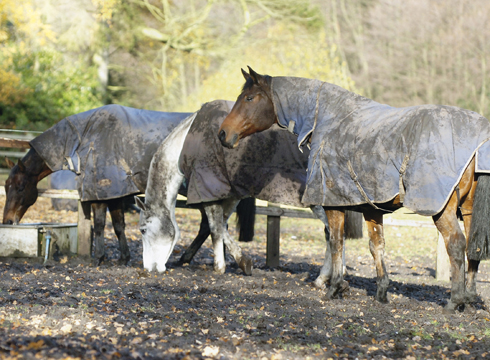Dealing with what this difficult season throws at us can be a challenge for horses and owners. So how can you weather the worst of winter? Karen Coumbe MRCVS offers some useful advice
Mud fever is annoyingly common in wet weather and treatment is not simple. Properly called pastern dermatitis, mud fever refers to a whole range of skin reactions to a number of different irritants.
Preventing a problem
Removing the horse from the mud is not always easy or possible, yet this will improve matters. If your horse has to be turned out, relying on barrier creams as protection against mud fever rarely works. Creams should be used with caution, as they may provide a suitable environment for bacteria to grow between the waterlogged skin and the greasy layers applied on top. Allowing the horse some time each day to stand in a dry stable will help.
If his legs are wet and muddy when you bring him in, try to let them dry thoroughly before brushing off the mud. A dry shavings bed will help absorb moisture from soaking wet limbs.
Sand schools can irritate the skin further, as can excessive washing to remove mud and scrubbing with a stiff brush. Any tiny scratches on the skin allow bacteria to invade. If you are about to ride and want to wash your horse’s legs off to put boots on, it can help to use warm water with dilute chlorhexidine (Hibiscrub) or a similar mild antiseptic before drying the legs thoroughly. Clean towels or kitchen paper can help blot moisture, while leg wraps that wick moisture away from wet skin are also beneficial.
What’s the cause?
Some horses with pastern dermatitis will be suffering from infestations of tiny chorioptic mange mites, similar to those that cause human scabies. This is most common in horses with long hair around their lower limbs, but can occur on less hairy legs. The condition is often called heel mange. Fungal infections can also be responsible for skin damage.
Neither mites nor fungal infections will be resolved with antibiotics. Another form of pastern inflammation is caused by a disorder of the body’s immune system, which attacks the skin. This is known as leucocytoclastic vasculitis and targets the unpigmented areas of the lower limbs. The condition tends to spread up the cannons. As it is usually seen on the outside and back of the limbs and sunlight is thought to aggravate it. It is a problem in both summer and winter and no amount of creams, lotions or antibiotics will work unil the inflammation is controlled. High doses of steroids that diminish the damaging inflammation are often the only effective cure and will be prescribed by your vet as necessary.
You will know if your horse’s pastern dermatitis involves bacteria because the skin appears red and sore with pus, like impetigo, a fairly common human skin rash. When a scab is picked off, the hair will come away with it, revealing a raw area with pus beneath. Views vary, but generally once this occurs, the legs need careful cleaning and the scabs may need to come off. Consult your vet to obtain an accurate diagnosis and a proper treatment plan.
The case against antibiotics
Just as there is a multitude of treatments for the common cold, there is a vast variety of mud fever remedies. No one cure is effective for all mud fever cases — best check with your vet first.
It is wrong to assume that all these pastern problems are caused by bacteria, so antibiotics are not necessarily the answer. Instead, they should be saved for the worst-case scenarios. Think carefully before considering antibiotics — or antimicrobials, as they are now properly called — for the horse with scabby legs, as they are unlikely to produce a permanent cure and may not help at all. They also increase the potential for antibiotic resistance. If there is a management improvement you can make, try that first.

